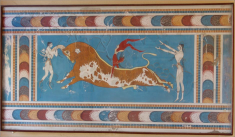Speaker
Description
Heavy quarks (i.e, charm and bottom) are produced at the very early stage of high energy nucleon-nucleon and heavy-ion collisions. These heavy quarks are produced mainly through initial hard parton-parton scattering with large momentum transfer (Q$^2$). In relativistic heavy-ion collisions, the heavy
quarks are produced much before the formation of deconfined medium consisting of quarks and gluons called Quark Gluon Plasma (QGP). The heavy quarks experience the full evolution by propagating through the medium and loses energy by successive elastic and inelastic collisions in that medium. Hence, heavy quarks are very sensitive probe to study the mechanisms of parton-energy loss, hadronisation and the transport properties of the medium produced in high energy heavy-ion collisions. In LHC (Large Hadron Collider) energies, the study of few features of heavy-ion collisions is possible in proton-proton collision. The production of heavy quarks through the hard process, can be described via theoretical model such as perturbative QCD (pQCD) calculations. Therefore, the measurement of heavy quarks in proton-proton (p-p) collisions provides an important test for pQCD and serves as a baseline for proton-ion (p-A) and ion-ion (A-A) collisions. In LHC, additional activities other than hard scattering are Underlying Event (UE) observables. One of the frequently used theoretical aspect of UE is multiple partonic interactions (MPI) based on non-pQCD system which deals with low momentum transfer in soft process. This softer partonic scatters (MPI) have significant contribution on total event multiplicity in high energy p-p collisions. MPIs are often described as the soft processes where light quarks are mainly produced, but there can be a contribution from hard and semi-hard scales. Semi-hard multiparton interactions are expected to be relevant for hard processes at LHC energies and contribute to heavy flavour particles production. In the link between hard and soft processes, the initial state and final state correlations may help understanding the origin of collectivity in small systems like p-p, p-A collisions. Few features like strangeness enhancement and formation of ridge strongly support the evidence of collective origin in high multiplicity p-p collisions. A charged-particle multiplicity dependent production measurement in p-p collision allows to study the interplay between soft and hard particle production mechanisms. To investigate the role of MPI on hard scale, one can study the heavy flavour production as a function of charged-particle multiplicity in p-p collisions at LHC energy regimes.
We shall present the production of leptons from heavy-flavour hadron decay as a function of charged-particle multiplicity in p-p collisions at LHC energies using PYTHIA8 event generators. The open heavy-flavour hadrons via their semi-leptonic decay channels are to be measured in central region ($|\eta| <$ 0.8) with electrons and at forward region ($−4. < \eta < −2.5$) with muons. The incorporation of MPI in PYTHIA8 may allow a good qualitative description of the multiplicity distribution. There is another frequently used phenomenological model which is called colour reconnection (CR) model. The collectivity in small systems has been studied with CR model. In PYTHIA8, there are three different models available for colour reconnection such as (i) MPI based model (CR=0), (ii) New QCD model (CR=1) and (iii) Gluon move model (CR=2). We shall add the CR model in the pythia8 simulation to estimate systematic uncertainties of our analysis.
Details
Will say later.
| Is this abstract from experiment? | No |
|---|---|
| Name of experiment and experimental site | N/A |
| Is the speaker for that presentation defined? | No |
| Internet talk | Yes |
